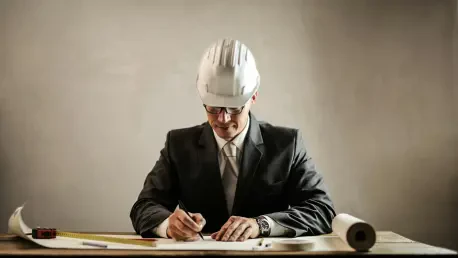Introducing Luca Calarailli, a notable expert in construction technology who stands at the forefront of architectural innovation. With an extensive background in design and a passion for integrating advanced technologies within the construction industry, Luca offers insights into the evolving landscape of smart technologies and artificial intelligence (AI). Today, you’ll gain an understanding of how these technological advancements are reshaping construction processes, enhancing efficiency, and improving project outcomes.
Can you explain the fundamental differences between artificial intelligence and smart technology in the construction and earthmoving industries?
Artificial intelligence and smart technology, while often used interchangeably, serve different purposes in construction. Smart technology refers to tools like sensors and drones that provide data and insights, helping teams optimize processes. AI, on the other hand, simulates human intelligence through learning and adaptation, making autonomous decisions. In construction, AI typically powers autonomous equipment, allowing machines to perform tasks with minimal human intervention.
What are some examples of smart technology currently used in construction and earthmoving?
Smart technologies prevalent today include drones, wearables, and advanced sensing devices. These technologies help teams monitor site conditions in real time, track material usage, and enhance safety measures. By offering a comprehensive overview of project progress, smart technology enables proactive decision-making that minimizes errors and enhances efficiency.
How do smart technologies, like sensors and drones, improve site management and project outcomes?
Smart technologies are game-changers for site management, providing unprecedented visibility and control. Sensors can monitor environmental conditions and resource allocation, while drones offer bird’s-eye perspectives of the site’s progress. This continuous flow of accurate data allows managers to make informed decisions quickly, reduce unnecessary delays, and improve overall project quality and safety.
Could you describe the capabilities of Komatsu’s Smart Construction Dashboard?
The Smart Construction Dashboard is a versatile digital tool that creates a virtual representation of a construction site. It consolidates data such as material quantities, site measurements, and potential issues into a single interface. This real-time access to information enables teams to plan effectively, avoid over-digging, and ensure material movements are precise, optimizing time spent on site.
How does the Smart Construction Dashboard help in reducing errors and improving efficiency on job sites?
By providing real-time insights, the Smart Construction Dashboard significantly reduces the likelihood of human error. The information it offers allows managers to anticipate and resolve issues before they escalate into larger problems. This foresight results in efficient project execution, minimizes the need for rework, and keeps projects on schedule.
What role does AI play in the earthmoving and construction industries?
AI’s primary role in earthmoving and construction is to bring a level of autonomy to machinery operations. It mimics decision-making processes, allowing machines to adjust to their environments and perform tasks with minimal guidance. This leads to enhanced efficiency, reduced labor costs, and in turn, increased project profitability.
Can you elaborate on how autonomous equipment works with AI to improve construction processes?
Autonomous equipment leverages AI to perform tasks traditionally handled by human operators. The AI uses algorithms to analyze data from various sensors, enabling the machinery to navigate site conditions, adjust operations efficiently, and perform tasks with consistent accuracy. This streamlining of operations benefits construction sites through faster project timelines and improved safety.
Could you describe how Smart Construction’s Edge product uses AI in drone surveying?
Smart Construction’s Edge product uses AI to simplify drone surveying. It processes the drone footage into a 3D point cloud, then employs an AI algorithm to automatically remove irrelevant objects like buildings and vegetation. This results in a clear, accurate site model that facilitates quicker and more precise site assessments.
How does the Smart Construction’s Edge product contribute to site progress measurement and challenge identification?
By providing a precise 3D site representation, the Edge product enables teams to track progress accurately and identify potential challenges from a comprehensive aerial perspective. This level of insight helps in pinpointing discrepancies and inefficiencies, allowing timely corrective actions to avoid project setbacks.
What trends do you foresee in the adoption of smart technology and AI in construction between now and 2030?
Going forward, I anticipate a significant increase in the adoption of these technologies. As smart tech becomes more affordable and user-friendly, more companies will integrate AI into their operations. This adoption will drive industry-wide digital transformation, leading to smarter, more sustainable construction practices.
How has the estimated market value for AI in construction changed from 2023 to the projected value in 2030?
The projected market value for AI in construction is poised for remarkable growth, from approximately £1.3 billion in 2023 to a staggering £9.1 billion by 2030. This exponential increase underscores the rapidly growing interest and investment in AI technologies within the sector.
How is Komatsu Smart Construction contributing to the digitalization of the construction industry?
Komatsu Smart Construction is at the forefront of digital transformation by offering solutions that enhance ease of use and interoperability. Their strategic integration of smart and AI technologies into mainstream construction practices highlights their commitment to driving industry innovation and efficiency.
Could you explain Komatsu’s approach to ensuring interoperability and ease of digital transformation for their systems?
Komatsu emphasizes seamless integration by ensuring their systems work harmoniously with existing technologies. This approach minimizes the disruption often associated with adopting new tech, allowing companies to transition smoothly into digital practices without overhauling their current systems entirely.
What challenges do you think the construction industry might face in implementing smart technologies and AI?
Adopting these technologies may face obstacles such as the high initial investment costs and the need for workforce training. There’s also a potential for resistance to change within traditional work environments. Addressing these challenges will require strategic planning and education to showcase the long-term benefits of tech adoption.
For a company looking to adopt smart technologies, what steps would you recommend they take to ensure a smooth transition into digital construction practices?
To facilitate a smooth transition, companies should start by assessing their specific needs and identifying technologies that align with their goals. Investing in training employees to effectively use new tools is paramount. Additionally, selecting technology with proven interoperability can significantly ease the shift towards more digital and automated construction practices.









